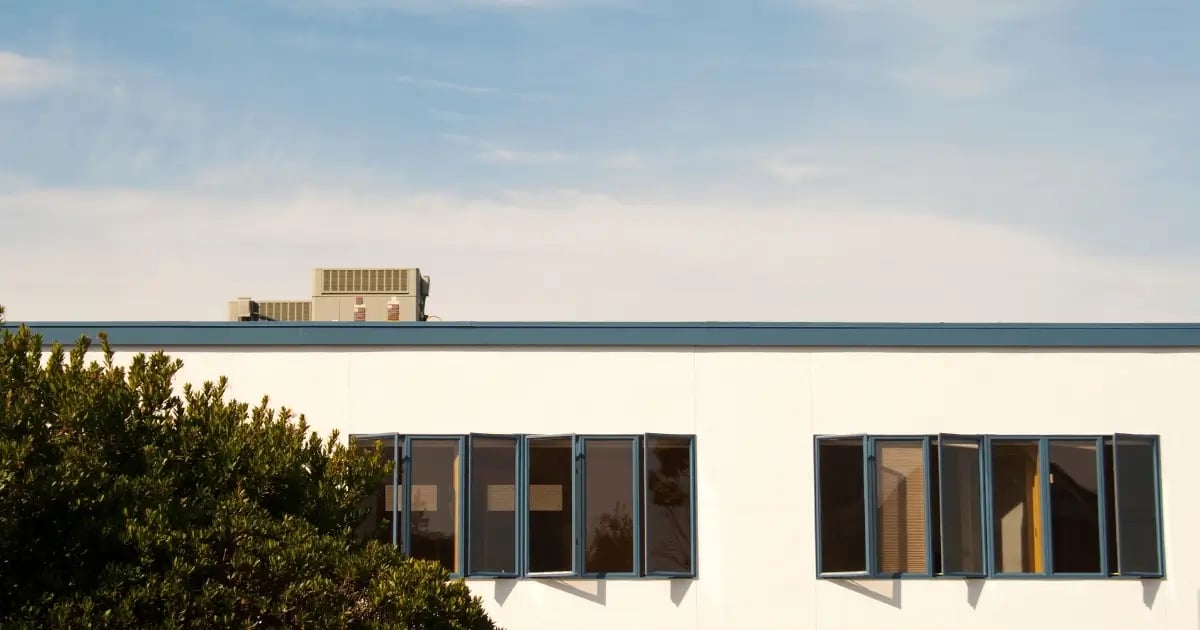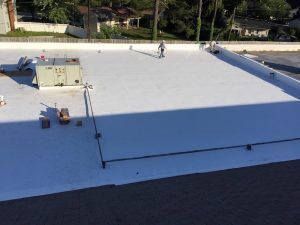Serving MD, DC & VA
Comprehensive Guide to Flat Roofs for Homes in Washington, D.C.

Flat roof systems require special attention that pitched roofs do not. If you own a home with a flat roof or are looking for a Flat Roofing Specialist in Washington DC, Maryland, or Virginia, it’s important to understand flat roof materials and construction, maintenance requirements, and everything else involved in taking care of your roof.
In this article:
Residential Flat Roof Materials & Construction in Washington, D.C.
Homeowners with flat roofs in Washington, D.C. can choose from several different types of flat roof materials, each of which has its own application and construction process, as well as its own pros and cons.
The three main types of flat roofs are:
1. Modified Bitumen Systems (MBS), including:
- Torch-down systems
- Self-adhering systems
2. Thermoplastic Polyolefin (TPO)
3. Ethylene Propylene Diene Monomer (EPDM)
We'll talk about each of these flat roof types in more detail below.
1. Modified Bitumen Systems (MBS)
Modified bitumen roofs are one of the most popular types of flat roof systems in commercial/industrial applications, and they're used residentially, as well. Modified bitumen systems (MBS) have become a popular alternative to built-up roofs (BUR) because MBS is lighter and more durable.
Modified bitumen is a type of bitumen (tar or asphalt) combined with a modifying compound, thus improving its performance. The two most common compounds used to modify roofing bitumen are: atactic polypropylene (APP) and SBS (styrene-butadiene-styrene).
The two common methods for applying modified bitumen flat roof systems are:
- Torch-Down Application (Torch Application): Torch-down roof application is the process of adhering levels of modified bitumen (APP type) through the application of high heat.
- Self-Adhering or Mop Application: SBS modified bitumen can be applied “cold” or without the use of high heat because of the addition of the styrene-butadiene-styrene compound. This process consists of applying self-adhering sheets or mopping the bitumen onto the roof platform.
Lifespan
An MBS roof's lifespan is 10-12 years when properly applied in appropriate settings.
Pros
- It comes in a variety of different types/applications to suit each home and homeowner.
- It is less complicated and requires less labor time to install than built-up flat roofs.
- Less complicated installation also means there is a smaller possibility of errors during installation.
- It is relatively low-cost.
- Modified bitumen is more flexible than built-up roofs, making it more elastic and durable against freezing temperatures.
- It can be recycled at the end of its lifespan.
Cons
- Torch application requires an open flame to apply, which requires special safety considerations.
- Extra attention must be paid to overlapping joints and pieces to avoid leaks.
Get a FREE Flat Roofing Quote »
(Maryland, DC, Northern VA only)
2. Thermoplastic Polyolefin (TPO)

TPO roofing is a type of synthetic “rubber roof”, consisting of a single-ply layer or membrane of thermoplastic polyolefin material. TPO is a popular material used in residential flat roofing applications because it is lightweight, highly reflective, and weather-resistant.
It comes in a standard white color, which helps prevent the absorption of heat. TPO roofing is also a popular choice for homes and buildings which have low-pitched (as opposed to flat) roofs because it can improve curb appeal with a unique appearance and is highly energy-efficient.
Lifespan
The average lifespan of TPO flat roofing in Washington, D.C. is 20 years with proper installation and maintenance.
Pros
- It has superior water resistance and leak protection.
- It is resistant to heat and UV rays.
- It is relatively cost-effective.
- TPO is relatively low-maintenance and easy to repair.
- TPO roofing is 100% recyclable.
- It offers reduced energy costs, especially in cooling costs.
- Relatively resistant to tearing and scratching.
- TPO is very lightweight, so roof decks and joints do not need reinforcement.
Cons
- TPO will age faster in regions with hotter temperatures.
- It’s important to make sure your TPO roofing product is high-quality and installed by a qualified professional, since many poor-quality TPO roofing products exist in the market.
Get a FREE Flat Roofing Quote »
(Maryland, DC, Northern VA only)
3. Ethylene Propylene Diene Monomer (EPDM)
EPDM, or ethylene propylene diene monomer, is another type of synthetic rubber roofing material. Like TPO, EPDM is commonly used as a single-ply membrane. However, EPDM differs from TPO in several ways.
EPDM is an older roofing technology than TPO, so it is considered more time-tested and trusted. However, EPDM does not offer the same heat-resistance and energy-saving technology as TPO roofing.
Over the years, EPDM roofing has evolved and is now available in peel-and-stick membranes, making for quick application.
Lifespan
The average lifespan of an EPDM rubber roof in Washington, D.C. is 25 years when properly applied in appropriate settings
Pros
- EPDM rubber roofing is waterproof (leaks are rare) and highly durable -- EPDM roofing doesn’t scratch easily.
- Repairs are relatively simple.
- EPDM is lightweight, so the roof deck typically doesn’t require reinforcement.
- EPDM roofing has a longer lifespan on average than either TPO or MBS.
Cons
- Exterior pipes, HVAC systems, chimneys, etc. can cause leaks unless properly flashed.
- It can be damaged by branches and storm damage.
- It is more prone to damage from foot traffic during and after installation.
- EPDM does not reflect heat like TPO.
Get a FREE Flat Roofing Quote »
(Maryland, DC, Northern VA only)
Maintenance of Flat Roofs for Homes in Washington, D.C.
One of the biggest reasons Washington, D.C. homeowners avoid flat roofs is because they require more maintenance than pitched roofs. However, if you know how to properly maintain a flat roof, you can mitigate this issue and enjoy the benefits of your Washington, D.C. flat roof without worry.
The following are the most important considerations when it comes to maintaining your flat roof.
Traffic Damage
This is number one on our list because to perform any type of maintenance or check on your flat roof, you’ll need to climb up and step foot on the roof. Your weight shouldn’t be enough to cause damage if the roof is properly installed. However, scuffing, scratching, or digging into roofing materials with sharp tools can damage a flat roof’s moisture-protectant layers.
Drains and Scuppers
Keeping the roof’s drains and scuppers clear is the second-most important step in maintaining your flat roof. Clogged drains make it impossible for water to drain off of the roof, forcing water to pool up on the roof instead.
Leaves and Debris
Gently sweeping the roof to prevent leaves and debris from building up can go a long way in maintaining your flat roof. Especially in the autumn months when leaves begin to fall, you’ll want to make sure you remove them from your roof before they turn to mulch.
Low Branches
Check the trees surrounding your house for low-hanging branches that touch--or come close to touching--your roof. These can easily begin to scrape and damage the roof before you have time to notice.
Caulking and Flashing
When you check your roof for damage, always check the caulking and flashing. These two parts are easy to replace, but if not maintained, can damage your entire roof system.
Professional Help
While some minor damage can be fixed DIY with patch kits from your local home center, larger or deeper cracks and splits require professional tools, experience, and equipment. If you’re not confident that you can seal any damage in a way that is completely watertight, call a professional flat roof contractor in Washington, D.C. or near you for help.
Get a FREE Flat Roofing Quote »
(Maryland, DC, Northern VA only)
Residential Flat Roof Myths and Facts
Flat roofs improve energy savings.
Fact. TPO flat roofs work to repel UV rays and prevent heat absorption, which means you can spend less money on cooling your home during the hot summer months.
Maintenance and repairs are easier on flat roofs.
Myth. While it may be easier to climb up and walk around on a flat roof, they also require special equipment and knowledge to maintain and repair. Flat roofs also require much more regular maintenance than pitched roofs.
Flat roofs add usable space to your home.
Fact. If you’ve ever been in the upstairs or attic space of a home with a steep-pitched roof, you know just how much space those roofs can take up. Valuable square feet can be saved by choosing a flat roof, which leaves all of the space underneath fully usable.
A flat roof also adds extra usable space to the exterior of a home, whether that means attaching the HVAC unit to the roof or installing a garden or rain buffering system atop your home.
Flat roofs are less expensive to install or replace.
Myth. Because they require special training and expertise to install correctly, flat roofs are typically more expensive to install or replace than pitched roofs.
Flat roofs are perfectly flat, so they can’t shed water.
Myth. Building codes usually require even “flat” roofs to have a minimum pitch of at least 1%, or ⅛” per 1’. Some building codes even require a slope of at least 2%. This minimum slope is enough to accommodate water runoff and to help prevent water damage. Flat roofs also utilize waterproof membranes to deter moisture.
Flat roofs don’t last as long as pitched roofs.
Fact. Because they are more prone to moisture, debris, and heat damage over time, flat roofs must be replaced more frequently than pitched roofs. However, modern materials like TPO and EPDM have extended the lifespan a great deal in recent decades, and flat roof technology continues to improve.
Flat roofs are a bad idea in hot regions.
Myth. While they may not last as long in areas of extreme heat, flat roofs made of materials like TPO can work well in even the hottest regions. We recommend TPO because it is white in color and works to reflect heat away from the home. Issues like cracking and blistering usually occur from improper application of roofing materials like modified bitumen and synthetic rubber.
You can replace a flat roof yourself.
Myth. DIY sites may claim that installing new flat roof materials like TPO and EPDM is simple enough to do yourself, but doing so can result in leaks, damage, and a roof replacement that lasts no more than a few years. Correctly replacing a flat roof requires the proper equipment, as well as professional training and experience.
Get a FREE Flat Roofing Quote »
(Maryland, DC, Northern VA only)
Washington D.C. Residential Flat Roof Financing and Warranty
With Capitol Improvements, you can trust your Washington DC-area home's flat roof to last for years or decades to come.
Material Warranty Period
Modified bitumen 12 years
TPO20 years
EPDM25 years
Capitol Improvements also offers easy financing for flat roofing projects in Washington, D.C., with options for great and not-so-great credit.
If you live in the D.C. area, contact us at Capitol Improvements to learn about how you can finance or get started on your Washington, D.C. flat roof project.
Raining this week
It’s a good time to leakproof your roof.
Minor leaks can turn into major issues quickly, don’t wait until you have to replace more than your roof. Request your free quote to quickly get a roof repair or a new leakproof roof.
